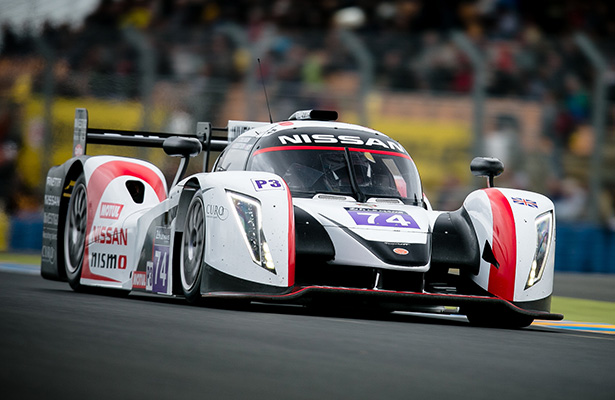
Photo: Nissan
TUDOR United SportsCar Championship teams may be getting a glimpse into the future on Monday when a LMP3 car makes its North American debut as part of an exploratory test for IMSA.
While flourishing in Europe, the new LMP3 platform is just one of the possible replacement options for the existing Prototype Challenge class in 2017, according to IMSA President and COO Scott Atherton.
“The goal of the test is to enable our current PC and potential future teams that would participate at that level within the championship to be able to make a fully informed decision,” Atherton told Sportscar365.
“The difference between reading about and hearing about and then personally experiencing it in a hands-on 20-minute on-track test is radically different.”
Monday’s test with the Ginetta-Nissan, the only race-ready LMP3 car currently on the market, will give IMSA and its customers additional data as a decision looms on the future prototype class structure.
While the LMP3 platform could offer an affordable solution for teams transitioning from the aging Oreca FLM09, some are not completely sold on the concept.
“My current customers have looked at it already and I’ve got to say they have no interest in it,” PR1/Mathiasen Motorsports team owner Bobby Oergel told Sportscar365.
“It’s just like the PC cars. They’re built to a price point and you put a lot more in it to make it an endurance car.
“My feeling is that mistake will happen again if we do this as the Challenge car.”
Similar to the LMP2 regulations, P3 cars are cost capped, with a maximum price of a turn-key car, fitted with the spec 5.0-liter Nissan V8 engine, is $217,000.
Despite being considerably cheaper than a current PC car, Oergel fears costs will again spiral out of control, particularly in adapting the cars for 10, 12 and 24-hour races.
Instead, he proposes that IMSA looks at adopting a new spec prototype based on one of the 2017 chassis and engine packages that would give customers greater flexibility and increased performance.
“If you did a spec P2 car package, with sealed dampers and everything, you eliminate a lot of the costs anyway,” he said. “Sure it’s going to be more expensive than a PC but it’s a lot more car than a PC.
“A guy has the opportunity at that point to be on the overall podium. A place like Daytona or Sebring, you could potentially be going for an overall win.
“I think that says a lot to the current clientele that we have because they don’t want to continue to do what they’re doing.
“Most of them don’t even have interest to run [in PC] next year because it’s played out.”
Starworks Motorsport team owner Peter Baron, however, feels the future direction should be P3.
“Other PC owners are trying to get a dumb-downed P2 car but there is no such thing,” Baron told Sportscar365. “It’s still a $1 million car at the end of the day.
“You can have your cost-capped [chassis] at 400,000 Euros, but by the time you’re done with it and get some spares it’s $1 million.
“The cost of running it is still P2 money. There’s really nothing else out there that makes sense.
“The Ligier [JS P3] car is gorgeous and we’re waiting to see Riley’s stuff. If they get a little over 500 horsepower in these things, then it can keep the costs under control. I think that’s the way to go.”
Baron, who is finalizing a P3 effort for the final two European Le Mans Series races of the year, is pushing for the introduction of the P3 platform in the TUDOR Championship for 2016.
It would theoretically see P3 cars compete alongside the existing PC cars in its final year of eligibility, through a Balance of Performance process.
“It’s easy enough,” Baron said of achieving a BoP for P3 and PC cars. “You look at a coupe and an open-cockpit car and it’s easy to do.
“I think the whole myth of having to get a coupe car has been greatly debunked by the Gibson [015S LMP2 car]. If you needed a canopy, somebody forgot to tell them.”
Atherton admitted it’s one of the options IMSA is exploring, should it decide to go the P3 route.
“I wouldn’t rule it out but that makes a lot of assumptions,” Atherton said. “It would be an interesting way of transitioning out of one [platform], a kind of elegant process to evolve from one into the other.”
IMSA has yet to confirm a timeframe for finalizing the class structure for its Pro-Am prototype division, although Atherton said they’d need to act quicker if any changes would be put in place for next year.
“We’re approaching this with a very open mind,” he said. “We have multiple choices, including an evolution into a LMP3 example.
“That could take one of several approaches: open competition as the ACO will have in P3 or defined, a specific chassis as we have today [in PC].
“There’s also the potential of not continuing at all in that category and opting to do a version of a P2 car that’s much more heavily regulated, cost-capped, with a much more limited performance capability.
“Part of that process for us is making sure we have full information before we make those decisions.”
























